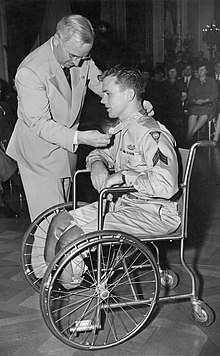Ralph G. Neppel
Ralph George Neppel (October 31, 1923 – January 27, 1987) was a United States Army soldier and a recipient of the United States military's highest decoration—the Medal of Honor—for his actions in World War II shortly before the Battle of the Bulge.
Ralph G. Neppel | |
|---|---|
 Neppel receives the Medal of Honor from President Harry S. Truman (August 23, 1945) | |
| Born | October 31, 1923 Willey, Iowa, US |
| Died | January 27, 1987 (aged 63) Lidderdale, Iowa |
| Place of burial | Holy Family Cemetery, Lidderdale, Iowa |
| Allegiance | United States |
| Service/ | United States Army |
| Years of service | 1943–1946 |
| Rank | Technical Sergeant |
| Unit | 329th Infantry Regiment, 83rd Infantry Division |
| Battles/wars | World War II |
| Awards | Medal of Honor |
Biography
Neppel joined the Army from Glidden, Iowa, in March 1943. By December 14, 1944, he was serving as a sergeant in Company M, 329th Infantry Regiment, 83rd Infantry Division. During a German counterattack on that day, at Birgel, Germany, one of his legs was severed by enemy fire. He continued to operate his machine gun until the German force withdrew. Neppel survived his wounds, although his remaining leg was badly damaged and had to be amputated. On August 23, 1945, he was awarded the Medal of Honor by President Harry S. Truman in a White House ceremony.
During his recovery and rehabilitation at McCloskey General Hospital in Temple, Texas, Neppel was fitted with prostheses and was promoted from sergeant to technical sergeant. He married his fiancee Jean Moore, and was discharged from the Army in 1946.[1]
Neppel returned to work at his 240-acre Iowa farm.[2] He earned a bachelors degree and attended graduate school, and worked for the Veterans Administration for 22 years. He served for eight years on the Iowa Governor's Committee for the Employment of the Handicapped, and in 1969 he was a finalist for the President's award for Handicapped Person of the Year.[3]
Neppel died in 1987 at age 63 and was buried in Holy Family Cemetery, Lidderdale, Iowa.
Medal of Honor citation
Sergeant Neppel's official Medal of Honor citation reads as follows:
He was leader of a machinegun squad defending an approach to the village of Birgel, Germany, on 14 December 1944, when an enemy tank, supported by 20 infantrymen, counterattacked. He held his fire until the Germans were within 100 yards and then raked the foot soldiers beside the tank killing several of them. The enemy armor continued to press forward and, at the pointblank range of 30 yards, fired a high-velocity shell into the American emplacement, wounding the entire squad. Sgt. Neppel, blown 10 yards from his gun, had 1 leg severed below the knee and suffered other wounds. Despite his injuries and the danger from the onrushing tank and infantry, he dragged himself back to his position on his elbows, remounted his gun and killed the remaining enemy riflemen. Stripped of its infantry protection, the tank was forced to withdraw. By his superb courage and indomitable fighting spirit, Sgt. Neppel inflicted heavy casualties on the enemy and broke a determined counterattack.
References
- Hering, E. L. (March 11, 1946). "Letters to the Editors". Life. Retrieved May 16, 2020.
- "Amputee Who Got Medal of Honor Sets Crop Record". The Washington Star. November 28, 1948. Retrieved May 16, 2020.
- "Ralph George Neppel". The Hall of Valor Project. Sightline Media Group. Retrieved May 16, 2020.
- Iowa Medal of Honor Heroes
- "Medal of Honor recipients - World War II (M-S)". Medal of Honor citations. United States Army Center of Military History. June 8, 2009. Retrieved 2007-11-27.